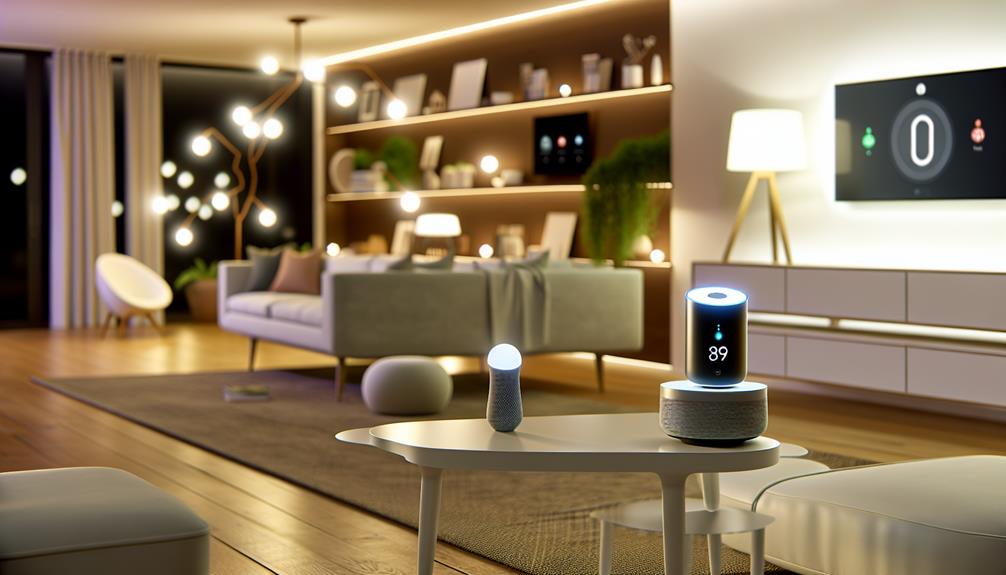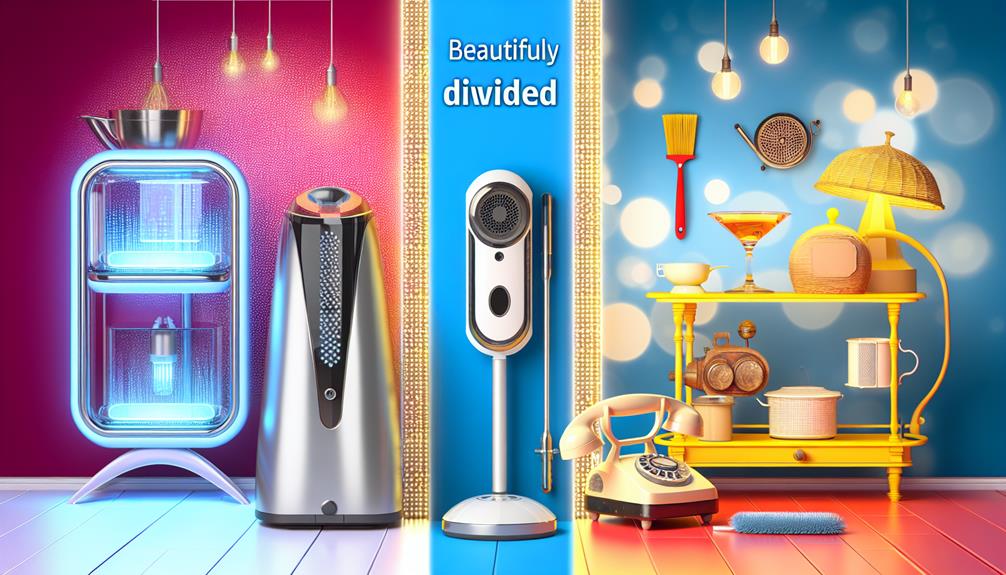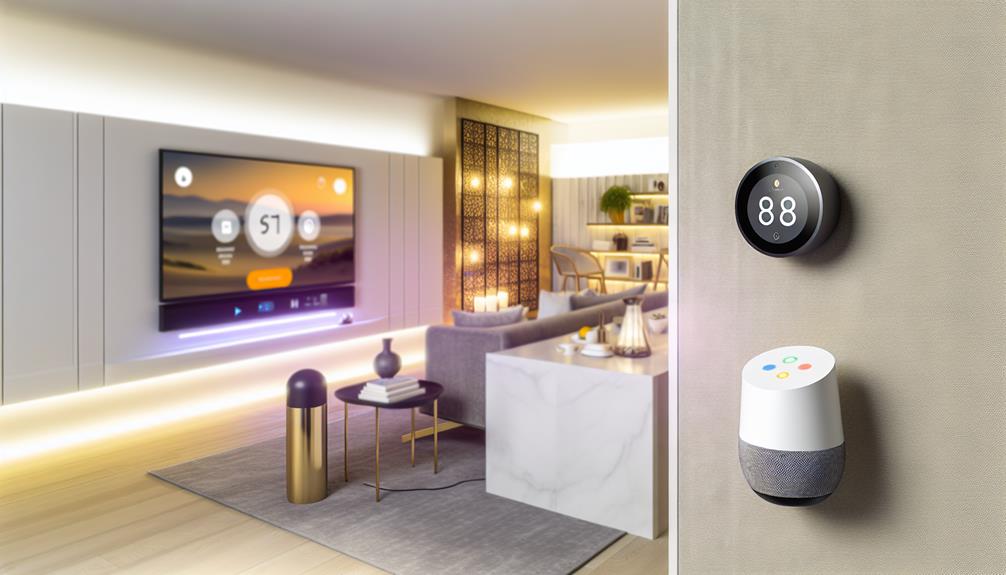7 Tips for Upcoming AI Smart Home Innovations
As the landscape of AI-driven smart home technology continues to advance, it is essential for homeowners and industry professionals alike to be informed about key strategies that can enhance functionality and efficiency. With a focus on seamless device integration, personalized user experiences, and enhanced security features, the following seven tips aim to guide users in optimizing their smart home environments. However, the implications of these innovations extend beyond mere convenience, hinting at a transformative impact on how we interact with our living spaces in the near future. What awaits us at the intersection of technology and daily life?
Key takeaways
- Embrace enhanced voice recognition for multilingual support, creating an inclusive and responsive smart home environment.
- Implement predictive home automation to anticipate user needs, enhancing comfort and optimizing energy efficiency.
- Focus on energy management solutions that facilitate real-time monitoring and integrate renewable energy sources for sustainability.
- Prioritize enhanced security features like AI-driven surveillance and biometric authentication for robust home protection.
- Ensure seamless device integration through universal compatibility standards, allowing for a cohesive and user-friendly smart home experience.
Enhanced Voice Recognition
Revolutionizing the way we interact with technology, enhanced voice recognition systems are transforming smart homes into intuitive environments. These advanced systems utilize contextual awareness to understand user commands more effectively, allowing for seamless interaction between individuals and their smart devices. By grasping the context in which a command is given, these systems can provide more relevant responses, making everyday tasks simpler and more efficient.
Multilingual support is another critical feature driving the evolution of voice recognition technology. As households become increasingly diverse, the ability to recognize and respond to multiple languages fosters an inclusive atmosphere. This functionality guarantees that all members of the household can engage with technology in their preferred language, promoting a sense of belonging and connectivity.
The integration of these sophisticated voice recognition capabilities enhances the overall user experience, making smart homes more accessible and responsive. Home automation, driven by these innovations, empowers users to customize their environments to suit their individual needs.
As technology continues to advance, the potential for enhanced voice recognition systems to create a more intuitive and inclusive living space will only grow, paving the way for smarter, more connected homes.
Predictive Home Automation
Predictive home automation leverages advanced algorithms to anticipate user preferences, creating a seamless living experience tailored to individual needs.
By optimizing energy efficiency, these systems not only reduce costs but also contribute to environmental sustainability.
Additionally, enhanced security features guarantee that homes are protected proactively, adapting to potential threats before they arise.
Anticipating User Preferences
As smart home technologies continue to evolve, the ability to anticipate user preferences emerges as a vital feature in predictive home automation. By analyzing user behavior, smart systems can create personalized experiences that enhance user engagement and promote lifestyle integration. This customization is achieved through sophisticated algorithms that recognize patterns in how individuals interact with their environments, tailoring settings and functionalities accordingly.
However, the integration of such predictive capabilities raises important considerations regarding data privacy. Users must feel secure that their personal information is protected while benefiting from enhanced convenience. Striking this balance is essential for fostering trust and encouraging adoption.
Moreover, as demographic trends shift, design aesthetics play a significant role in ensuring that smart home technologies resonate with diverse user groups. Feature customization allows users to align technology with their unique tastes and preferences, creating a sense of belonging within their living spaces.
Lastly, implementing feedback loops enables continuous improvement of predictive algorithms, ensuring that devices evolve alongside user needs. By focusing on these aspects, smart home innovations can successfully anticipate user preferences, creating environments that are not only functional but also emotionally resonant.
Energy Efficiency Optimization
A growing number of households are prioritizing energy efficiency, making it a central focus of smart home innovations. With the integration of intelligent appliances and eco-friendly systems, homes are becoming more sustainable while enhancing comfort and convenience.
One of the most promising developments is the use of smart grids, which facilitate the incorporation of renewable energy sources, allowing homeowners to harness solar or wind power effectively.
Demand response strategies enable real-time monitoring of energy consumption, allowing for automated scheduling that optimizes usage during off-peak hours. By leveraging behavioral analytics, these systems can learn individual habits and adjust energy consumption accordingly, leading to significant savings.
Furthermore, conducting energy audits can provide insights into areas for improvement, while consumption forecasting helps predict future energy needs. This holistic approach not only reduces utility bills but also contributes to environmental sustainability.
As homeowners seek a sense of belonging in eco-conscious communities, energy efficiency optimization through predictive home automation stands out as a crucial innovation in the smart home landscape. Embracing these technologies fosters a more connected, responsible lifestyle, aligning personal values with global sustainability goals.
Enhanced Security Features
The integration of smart home technologies not only enhances energy efficiency but also markedly improves security measures. Enhanced security features leverage artificial intelligence to create a safer living environment through predictive home automation. By employing tools like facial recognition and biometric authentication, homeowners can guarantee that only authorized individuals gain access to their property.
Remote monitoring capabilities allow residents to observe their homes in real-time, while anomaly detection identifies unusual activities, triggering immediate responses. Real-time alerts keep homeowners informed of potential threats, enabling swift action.
The following table summarizes key enhanced security features:
| Feature | Description | Benefits |
|---|---|---|
| Facial Recognition | Identifies people entering the home | Enhanced access control |
| Biometric Authentication | Uses unique physical traits for security | Increased safety |
| Remote Monitoring | Live video feeds accessible via smartphone | Peace of mind |
| Anomaly Detection | Alerts based on unusual patterns or activities | Proactive threat assessment |
| Data Encryption | Secures data transmission and storage | Protects privacy controls |
Incorporating these technologies fosters a sense of belonging and safety, empowering homeowners to protect their loved ones and property effectively.
Energy Management Solutions
Steering through the complexities of energy consumption in our homes has never been easier, thanks to innovative energy management solutions powered by artificial intelligence.
These advancements not only enhance our lifestyles but also foster a sense of community responsibility towards sustainable living.
By integrating with the smart grid, AI-driven systems facilitate:
- Real-Time Monitoring: Track energy usage patterns, empowering homeowners to make informed decisions.
- Automated Scheduling: Optimize energy consumption by scheduling appliances during off-peak hours, minimizing costs.
- Demand Response: Actively adjust energy usage in response to grid demands, ensuring stability and reliability.
- Renewable Integration: Seamlessly incorporate solar or wind energy, reducing your carbon footprint and enhancing energy storage capabilities.
These solutions promote load balancing and peak shaving, enabling us to manage energy flow efficiently.
With energy analytics, homeowners can visualize their consumption trends, supporting a collective effort in reducing environmental impact.
As we embrace these technologies, we strengthen our commitment to a sustainable future, fostering a community that values innovation and responsibility.
In this new era of energy management, we can all contribute to a greener, more efficient home.
Advanced Security Features
While energy management solutions are transforming how we interact with our environment, advanced security features are equally revolutionizing the safety of our homes. The integration of biometric authentication has emerged as a cutting-edge method to enhance home security, allowing only authorized individuals access through fingerprints or facial recognition. This technology not only provides a personalized experience but also guarantees that your home remains a safe haven.
In addition to biometric systems, smart surveillance technology is becoming increasingly sophisticated. Modern security cameras equipped with AI capabilities can distinguish between family members, pets, and potential intruders, sending real-time alerts to homeowners. This proactive approach to security fosters a sense of community, as neighbors can collaborate through shared surveillance networks, further enhancing safety.
Moreover, these innovations promote peace of mind, reassuring families that their spaces are protected, even when they are away.
As you consider integrating these advanced security features into your smart home, remember that a secure environment nurtures a sense of belonging and well-being. Embracing these technologies empowers you to create a haven that evolves with our ever-changing world.
Seamless Device Integration
Seamless device integration is essential for creating a truly connected smart home environment, relying on universal compatibility standards to guarantee that various devices can communicate effectively.
Centralized control systems further enhance this experience by allowing users to manage multiple devices through a single interface.
This integration not only simplifies user interactions but also maximizes the efficiency and functionality of smart home technologies.
Universal Compatibility Standards
In today's rapidly evolving smart home landscape, universal compatibility standards play a pivotal role in guaranteeing that devices from various manufacturers can work together harmoniously.
These standards foster device interoperability, allowing homeowners to create customized environments that cater to their unique lifestyles. By adhering to universal protocols, manufacturers simplify the integration process and enhance user experience.
Consider the benefits of universal compatibility standards:
- Enhanced Connectivity: Different devices can communicate seamlessly, reducing connectivity issues.
- Diverse Ecosystem: Homeowners can choose from a wide range of devices, regardless of brand, promoting diversity in smart home solutions.
- Simplified Setup: Installation becomes straightforward, minimizing frustration and maximizing usability.
- Future-Proofing: As new technologies emerge, universal standards guarantee that existing devices remain relevant and functional.
As we embrace the future of smart homes, it is essential to prioritize compatibility.
Centralized Control Systems
Universal compatibility standards create a solid foundation for the next step in smart home evolution: centralized control systems. These systems leverage smart hub technology to facilitate seamless device integration, ensuring that various products communicate effectively through standardized automation protocols.
This interoperability enhances user experience and fosters a sense of belonging within the smart home ecosystem.
An intuitive user interface design is vital, enabling homeowners to manage their devices effortlessly. Enhanced cloud connectivity allows for remote access solutions, ensuring users can monitor and control their systems from anywhere.
As technology advances, regular software updates will be essential to maintain functionality and security, particularly concerning data privacy.
Moreover, user feedback integration is significant for refining these centralized systems, helping developers understand real-world needs and preferences. This iterative process enhances system scalability, allowing users to expand their smart home networks without compatibility issues.
As we embrace these innovations, centralized control systems will not only simplify our lives but also create a connected environment that fosters community and belonging, making smart homes a truly integrated part of modern living.
Personalized User Experiences
A growing number of smart home devices are now capable of delivering personalized user experiences that adapt to individual preferences and routines. This shift towards customized automation enhances comfort and efficiency, fostering a sense of belonging within the home environment.
By leveraging user-centric design principles, manufacturers are creating systems that learn and evolve with their users.
Consider the following key features that contribute to a personalized smart home experience:
- Adaptive Lighting: Smart bulbs that adjust brightness and color based on the time of day or user mood.
- Voice-Activated Assistants: Devices that recognize individual voices and provide tailored responses or reminders.
- Automated Climate Control: Thermostats that learn your schedule to maintain ideal comfort throughout the day.
- Personalized Security Alerts: Systems that differentiate between family members and guests, customizing notifications for safety and convenience.
These innovations not only improve daily living but also create a harmonious atmosphere where technology seamlessly integrates into personal lifestyles.
Embracing such advancements allows users to feel more connected and in control of their smart home experience, ultimately enriching their lives.
Sustainable Smart Technology
Sustainable smart technology represents a pivotal shift in how households consume energy and manage resources. By integrating eco-friendly appliances and renewable energy solutions, homeowners can markedly reduce their environmental footprint. This technology not only focuses on energy efficiency but also encompasses responsible sourcing of sustainable materials, enhancing the overall sustainability of home environments.
Consider the following table illustrating key aspects of sustainable smart technology:
| Feature | Benefits | Examples |
|---|---|---|
| Smart Gardening | Enhances yield while conserving water | Automated irrigation systems |
| Eco-Friendly Appliances | Lower energy consumption | Energy Star certified devices |
| Solar Integration | Harnessing renewable energy | Solar panels and batteries |
| Waste Reduction | Minimizes landfill contributions | Smart composting systems |
Moreover, green certifications provide assurance that products meet environmental standards, while energy harvesting technologies maximize energy use. By prioritizing water conservation and adopting these innovations, families can cultivate a sustainable lifestyle that fosters community belonging and a collective commitment to protecting our planet. Embrace these advancements to create a greener, smarter home for future generations.
Frequently Asked Questions
How Will AI Impact Home Design in the Future?
AI will revolutionize home design by enabling intelligent layouts that optimize space utilization and promote comfort. Additionally, automated aesthetics will allow for personalized environments, enhancing both functionality and emotional well-being in residential settings.
Are There Privacy Concerns With AI Smart Home Devices?
In a world where your toaster knows your breakfast preferences better than you do, privacy concerns about AI smart home devices loom large. Data security and user consent are paramount to guarantee a comfortable, secure living environment.
What Are the Costs Associated With Upgrading to AI Technology?
Upgrading to AI technology entails installation expenses, which can vary considerably based on system complexity. However, these costs may be offset by long-term savings in energy efficiency and enhanced automation, fostering a sustainable living environment.
How Can AI Improve Elderly Care in Smart Homes?
In the domain of elderly care, AI serves as a vigilant guardian, offering remote monitoring and personalized assistance. This transformative technology fosters independence, enhances safety, and nurtures a sense of belonging within smart home environments.
Will AI Smart Home Devices Work Without Internet Connectivity?
AI smart home devices can operate without internet connectivity through local processing and offline capabilities. This guarantees essential functionalities remain intact, providing users with reliable control and security, even in the absence of a stable internet connection.



